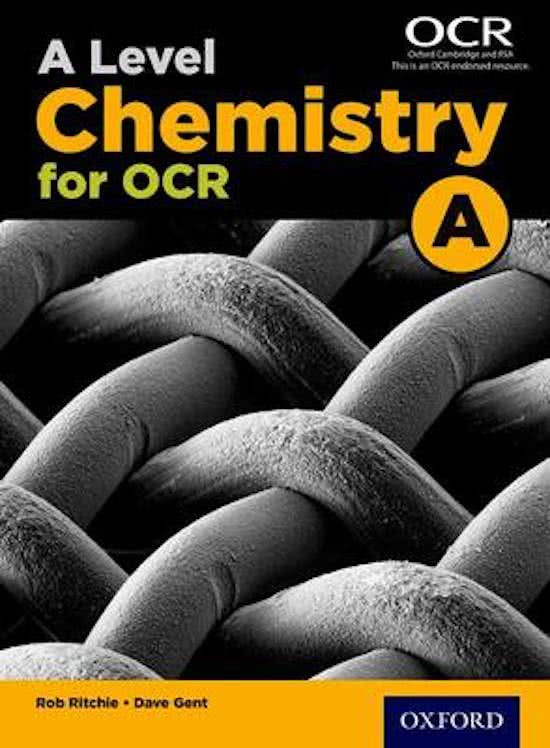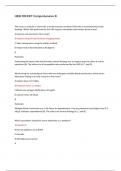Module 2
2.1.1
Isotopes are atoms of the same element with different numbers of neutrons but the same number of protons
and electrons, therefore isotopes have the same atomic number but different mass numbers.
Subatomic Relative Relative
Particle Charge Mass
Proton +1 1
Neutron 0 1
Electron -1 1/2000
All isotopes of an element have the same chemical properties as they have the same number of electrons in
their outer shell and the same electronic configuration.
Relative isotopic mass is the mass of the isotope compared with 1/12th of the mass of an atom of Carbon-12
Relative atomic mass (Ar) is the weighted mean mass of an atom of an element compared with 1/12th of the
mass of an atom of Carbon-12. (Based on the mass of a 12C atom, the standard for atomic masses)
Mass spectrometry:
A mass spectrum is a graph showing the relative abundance (often as a percentage) on the y axis and the mass:
charge (m/z) ratio on the x axis. For the purposes of most AS questions we can take the charge to be +1,
therefore m/z becomes simply the relative isotopic mass of the particle.
The Ar can be calculated:
Ar= (Relative abundance x m/z of Isotope 1) + (Relative abundance x m/z of Isotope 2) … / sum of relative
abundances
When rearranging, if the general element is used, rather than a sample, A r from the periodic table may be used
This can be rearranged to calculate the relative abundances of two isotopes through the use of simultaneous
equations by substitution of x and y. E.g. x+y=sum of relative abundances being one of the simultaneous
equations.
Relative molecular mass (Mr) is used for simple molecules and relative formula mass is used for compounds
with giant structures
2.1.2
, Name of ion Formula
Nitrate NO3-
Sulphate SO42-
Carbonate CO32-
Hydroxide OH-
Ammonia NH3
Ammonium NH4+
Zinc Zn2+
Silver Ag+
Phosphate PO43-
Roman numerals are used for transition elements to show the oxidation number, as transition elements can
form many different ions. The name without these roman numerals is ambiguous:
- (I): 1
- (II): 2
- (III): 3
- (IV): 4
- (V): 5
- (VI) :6
2.1.3
The mole (mol) is the unit for amount of substance (n)
2.1.1
Isotopes are atoms of the same element with different numbers of neutrons but the same number of protons
and electrons, therefore isotopes have the same atomic number but different mass numbers.
Subatomic Relative Relative
Particle Charge Mass
Proton +1 1
Neutron 0 1
Electron -1 1/2000
All isotopes of an element have the same chemical properties as they have the same number of electrons in
their outer shell and the same electronic configuration.
Relative isotopic mass is the mass of the isotope compared with 1/12th of the mass of an atom of Carbon-12
Relative atomic mass (Ar) is the weighted mean mass of an atom of an element compared with 1/12th of the
mass of an atom of Carbon-12. (Based on the mass of a 12C atom, the standard for atomic masses)
Mass spectrometry:
A mass spectrum is a graph showing the relative abundance (often as a percentage) on the y axis and the mass:
charge (m/z) ratio on the x axis. For the purposes of most AS questions we can take the charge to be +1,
therefore m/z becomes simply the relative isotopic mass of the particle.
The Ar can be calculated:
Ar= (Relative abundance x m/z of Isotope 1) + (Relative abundance x m/z of Isotope 2) … / sum of relative
abundances
When rearranging, if the general element is used, rather than a sample, A r from the periodic table may be used
This can be rearranged to calculate the relative abundances of two isotopes through the use of simultaneous
equations by substitution of x and y. E.g. x+y=sum of relative abundances being one of the simultaneous
equations.
Relative molecular mass (Mr) is used for simple molecules and relative formula mass is used for compounds
with giant structures
2.1.2
, Name of ion Formula
Nitrate NO3-
Sulphate SO42-
Carbonate CO32-
Hydroxide OH-
Ammonia NH3
Ammonium NH4+
Zinc Zn2+
Silver Ag+
Phosphate PO43-
Roman numerals are used for transition elements to show the oxidation number, as transition elements can
form many different ions. The name without these roman numerals is ambiguous:
- (I): 1
- (II): 2
- (III): 3
- (IV): 4
- (V): 5
- (VI) :6
2.1.3
The mole (mol) is the unit for amount of substance (n)












